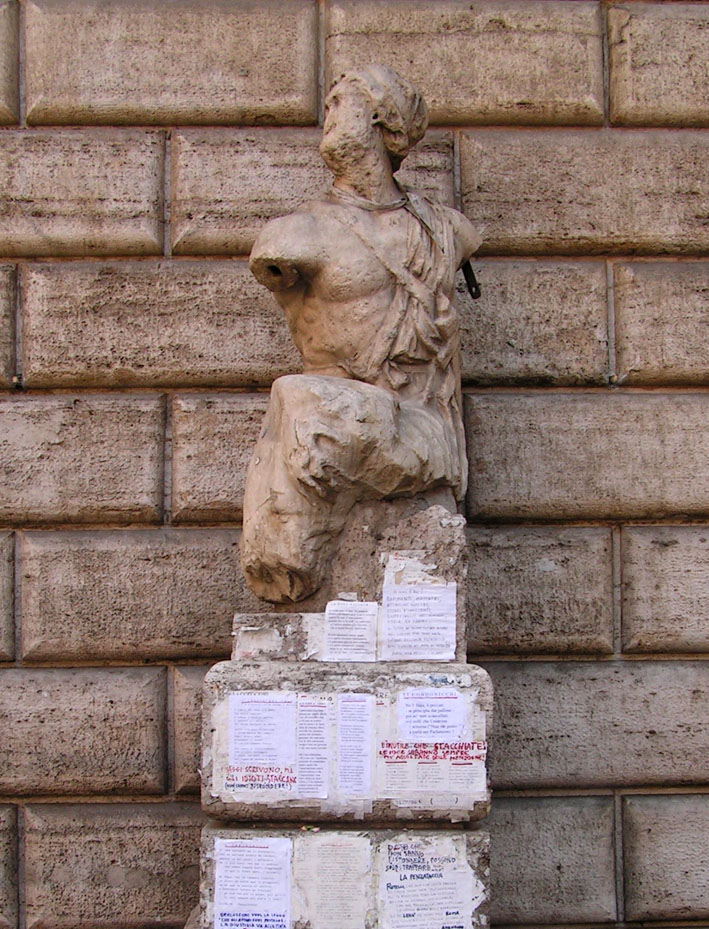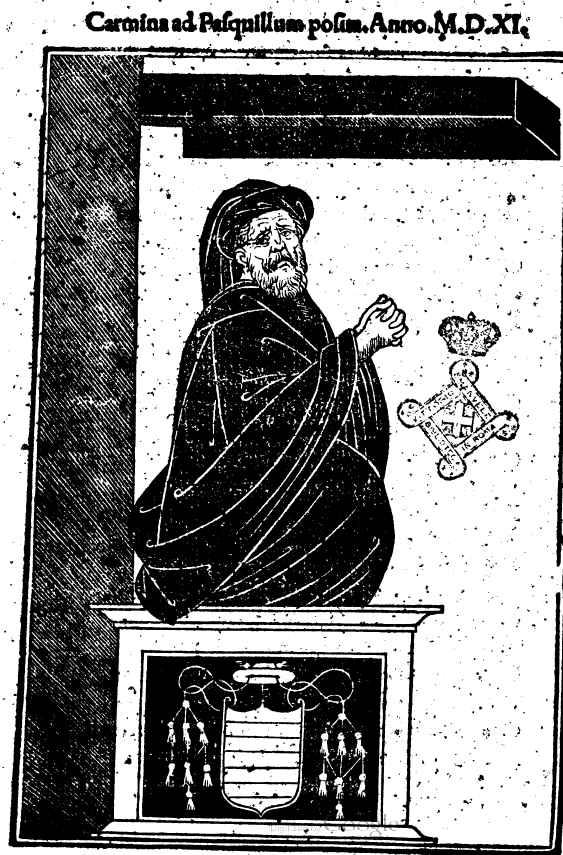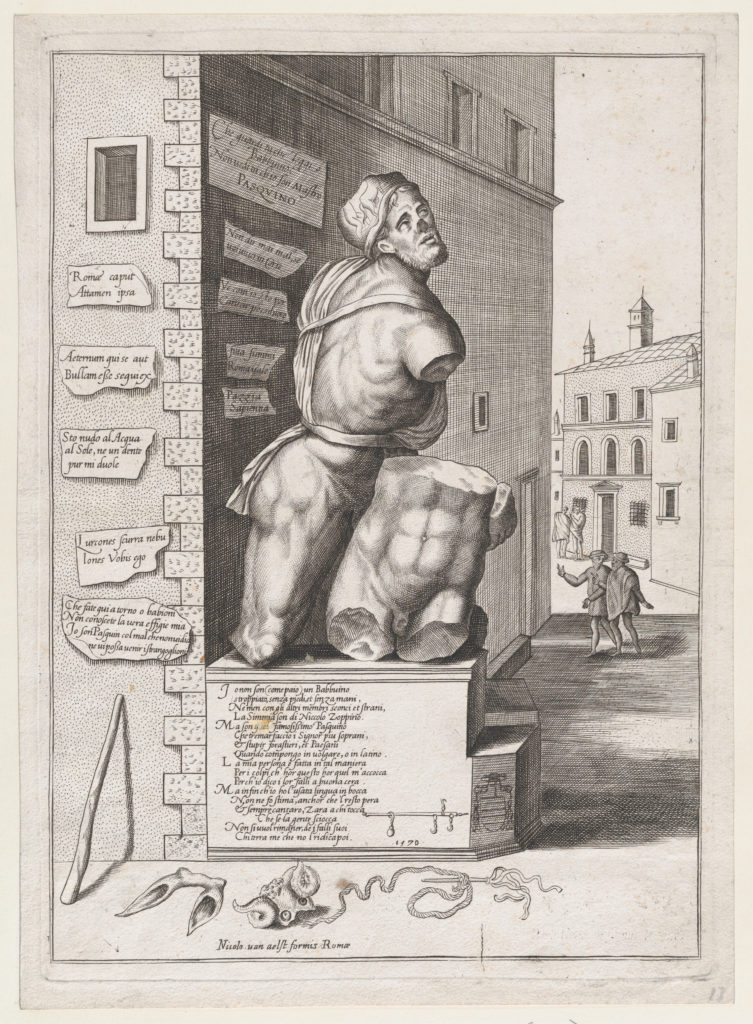By Samuel Oer de Almeida,
a Classical archaeologist from Germany
Following the rediscovery of ancient Greek and Latin authors by Italian humanists in the late 14th century, the growing reception of ancient literature was accompanied by a general interest in ancient civilisations. The contemporary aristocracy of the eternal city Rome was quite fast in appropriating the ancient material culture as well. During the following centuries, numerous excavations took place in and around Rome. Precious parts of ancient buildings were reused in modern aristocratic palazzi, while statues were carefully transported and displayed in courtyards and gardens. Partly, these sculptures underwent a period of heavy reinterpretation by the contemporaries who constructed their own image of antiquity. More than a few statues were put up at public places, especially at highly vivid squares. Six of them became famous as the statue parlanti di Roma, the talking statues of Rome.

During building works in the 14th century at the Piazza di Parione (today Pasquino) southwest of the Piazza Navona in Rome, a quite heavily damaged statue was found under a house and subsequently used as a stepping stone. In 1501, the Italian cardinal Oliviero Carafa re-erected the sculpture at the southeast corner of the square near the Palazzo Orsini, which was eventually replaced by the Palazzo Braschi in the 18th century. The erection of the damaged and therefore quite unusually looking statue at a busy public space, of course, promptly sparked creative interaction. Very early, the Roman population gave the statue, as the fellow citizen it was, the name Pasquino. Several surviving anecdotes try to explain its name in connection to different individuals: For example, a schoolmaster named Pasquino is quoted as a preferred model. But the most famous anecdote refers to a local craftsman, who was notorious for his sarcasm and under whose shop the statue originally should have been found. Another, rather reasonable, hypothesis connects the name with an annual Easter feast (Italian = pasqua) which partly took place on the square in front of the statue. Each year, on the 25th of April, the feast day of Saint Mark the Evangelist, priests made a procession through the city in which they also visited Pasquino. The sophisticated circle around cardinal Carafa encouraged him to let artists dress up the ancient statue on occasion of the feast’s procession. Therefore, Pasquino was annually transformed into different figures, mainly deriving from ancient mythology, using gypsum, fabric, and colour. A surviving Latin poem of 1511 records the phenomenon:
Quot Proteus variis vertit sua membra figuris,
Pasquillo totidem Roma dat ora suo;
Nam nunc Harpocrates, Cyllenius aut dea Florum,
Et nunc Alcides, mox at Asellus erit.
As much Proteus [sea god] variously shifts his outer shape,
As Pasquillo gives his faces to Rome;
For he will be now Harpocrates, Cyllenius [Mercury], or goddess Flora,
And now Alcides [Heracles], but soon a donkey.
Besides Harpocrates, Mercury, Flora, Hercules, and—quite exceptional—a donkey, several other costumes are recorded: Jupiter, Bacchus, Saturn, Ceres, Venus, and eventually, on occasion of cardinal Carafa’s death in 1511, as a mourning cleric.

Remarkably, the transformation did not stop at gender boundaries as well as at the divine or human nature of its model. Subsequently to the cardinal’s death, other clerics, even popes, patronised the annual ritual.

Eventually, during the annual feast, pupils and students attached up to 3,000 slips of paper with Latin verses fitting each year’s costume at the statue’s base and the nearest wall. A practice, or rather poetic competition, which was even supervised by a so-called secretarius magistri Pasquilli who controlled the quality of the short poems. But not enough; these so-called Pasquinates were in fact collected, edited, and published in print. However, it did not take long until notes were attached around the sculpture independently of the annual feast. The practice did not just expand in terms of time but also in terms of content: The dilettante poems made way for critical comments on politics and society, and harsh satires of the Roman Curia. Pasquino even entered into dialogue with the other talking statues of Rome, such as the Marforio, who is nowadays displayed in the Palazzo Nuovo on the Capitoline Hill. Pope Adrian VI was so furious about Pasquino’s cynical messages that he even considered to drown the statue in the Tiber. According to an anecdote, we owe it to an Italian nobleman, who remarked that Pasquino would continue to mock the pope as a frog in the river, that the pope finally decided to endure the statue’s infinite mockery. Therefore, the way was paved for the practice to continue until the late 19th century—and in considerably smaller format until today. Moreover, centuries of unprotected exposure to wind and weather gnaw at the marble statue. In consequence, several restorations were carried out to preserve its presence in the city.
Beginning with the early 16th century Pasquino became one of the most famous publicly exhibited ancient statues of Rome. Pasquino’s popularity primarily bases on its role as one of the earliest statua parlante of Rome. Pasquino, or more precisely the practice of writing and attaching critical notes around him, had a distinctive social function: The mode of display of these messages equalled putting the written words into his mouth. Pasquino allowed voices of dissent to be expressed anonymously whilst providing a ritual form for catharsis; that these voices were indeed heard or at least in some way perceived by the criticised ruling class, in this case mainly the papacy and the Roman Curia, shows the abovementioned anecdote of Pope Adrian VI which certainly does not portray historical facts, but gives a hint at the papacy’s sentiment against political opposition. The statue also emanated harsh dissent at the visit of Napoleon to Rome or later that of Hitler in 1938. Thus, the statue impersonated the archetypical Roman citizen giving a defying voice for anonymous disagreement and integrating it into the general sociopolitical discourse. Last but not least, Pasquino acted and acts as a symbol of freedom of expression.
Besides acting as a collective vox populi, the Pasquino inspired artists, namely the famous 17th century Italian sculptor and architect Gian Lorenzo Bernini who praised the severely damaged statue as the most beautiful ancient work of art—whilst not withstanding to freely attribute it to famous ancient sculptors, like Phidias or Praxiteles. Bernini believed the statue to represent a soldier of the Macedonian king Alexander the Great carrying of his wounded sovereign from the battlefield. As it was, he could not underpin his interpretation with sustaining arguments, what also really was not a task prioritised by his time and cultural surrounding. Due to the bad state of the statue’s preservation, various other interpretations rose making it a real opera operta, a work of art whose recipients—not its creator—are the driving force of giving meaning: Pasquino was thought to display Hercules, Mars, or even a gladiator. In our days, archaeology and art history are quite sure in interpreting Pasquino as a statue group of two persons also surviving in other more exhaustive copies across the Italian peninsula and beyond: An upright standing male figure with a beard puts his arms around a deadly wounded cowering figure. The group displays a scene from the Trojan War in which the Greek hero Ajax rescues the dead body of his fellow combatant Achilles under threat of the hostile Trojans in order to cremate it according to religious customs.
While being a relative peripheral object of study in modern research, the extraordinarily vivid reception and repurposing of the statue beginning in the early 16th century show several different aspects of the handling of ancient material culture which forms an influential part of our own cultural heritage.
Further Reading
Cancellieri, F. 1789: Notizie delle due famose statue di un fiume e di Patroclo dette volgarmente di Marforio e di Pasquino, Rome.
Ciancio Rossetto, P. 2016: ‘Pasquino. Riflessioni e acquisizioni dal restauro’, in C. M. d’Annoville and Y. Rivière (eds), Faire parler et faire taire les statues. De l’invention de l’écriture à l’usage de l’explosif, Collection de l’École française de Rome 520, Rome, 11–27.
Giannottu, C. 2016: ‘La voix de Pasquin. Écriture affichée, satire politique et mémoire dans la Rome contemporaine’, in C. M. d’Annoville and Y. Rivière (eds), Faire parler et faire taire les statues. De l’invention de l’écriture à l’usage de l’explosif, Collection de l’École française de Rome 520, Rome, 29–44.
Rendina, C. 1996: Pasquino, statua parlante. Quattro secoli di pasquinate, Rome.
Virgili, P. 1993: ‘Restauro delle statue parlanti’, Bullettino della Commissione archeologica comunale di Roma (N. S.) 95 (2), 121–128.
Wünsche, R. 1991: ‘Pasquino’, Münchner Jahrbuch der bildenden Kunst 42, 7–38.
